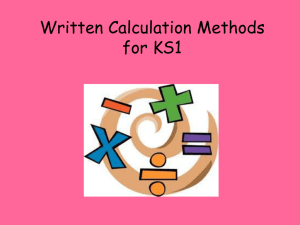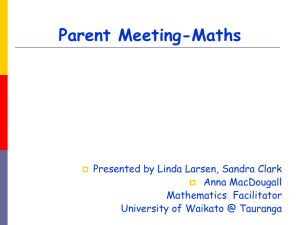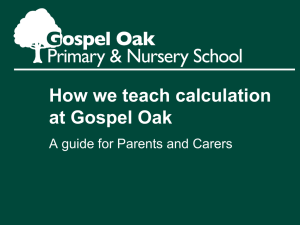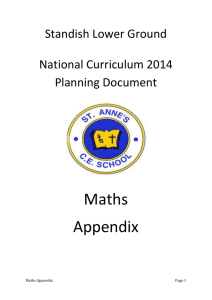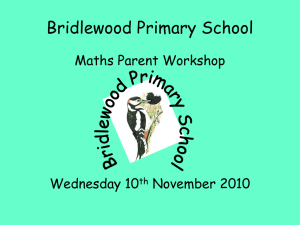Using Number Lines - Lancashire Grid for Learning
advertisement
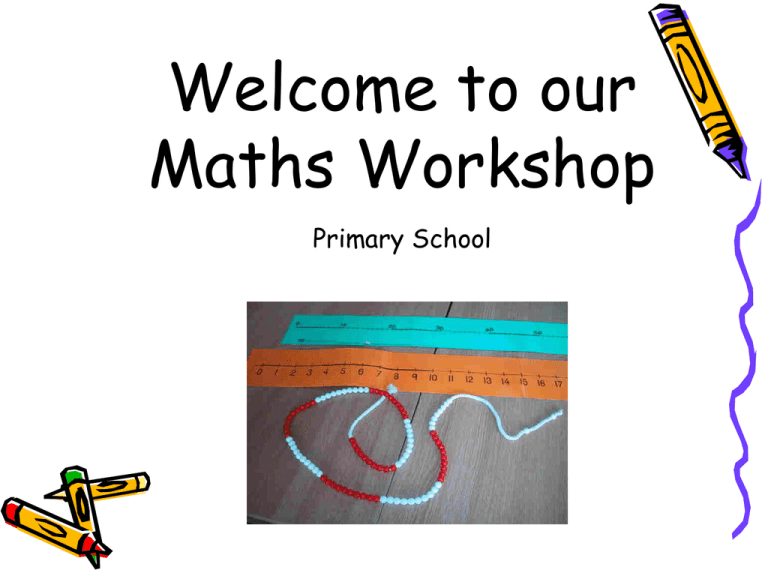
Welcome to our Maths Workshop Primary School Adult attitude to maths Jenny: ‘My first thoughts of mathematics are fear, not being able to do it and feeling inferior.’ DfEE 1999 (10 years ago!) ‘Parents who are confident about maths tend to have children who are also confident, and these children are ready to tackle and assimilate new ideas in a way that is impossible for children who feel uncertain about, or even fear, maths.’ I find it much easier if I have some help at home! 78 – 12? How do you work out…. 20 - 6 74 – 57? Lancashire Mathematics Team 20-6 14 15 20 78 - 12 66 66 78 68 76 78 74 - 57 57 57 60 74 67 74 Subtraction with decimals on a number line The many uses of a number line Imagine: A similar situation where the pupils are finding Problem solving with decimals (money and time) difficult to access. The train is due to arrive at 6.45am but is 37 minutes late. What time does it arrive? How might a number line help? Addition - Number lines Are frequently used in each year group and provide children with a very visual method of calculation • 15 + 8 = • 29 + 23 = Can you get from a starting number to 100 in 3 hops? • 27 + ? = 100 • 48 + ? = 100 • 2 + ? = 100 Number lines can help with estimating • Where would 660 be on this number line? (demonstration) 600--------------------------------------700 • Where would 310 be on this number line? 240--------------------------------------360 I told you to use a number line! Have a go! • 22 – 5 = • 145 – 94 = • The bus is due to arrive at 7.35am but is 46 minutes late. What time does it arrive? • Sally wants to buy a CD that costs £15.60. She only has £13.45. How much more money does Sally need to buy the CD? A number line is just a ‘picture’ of how we work out some calculations in our heads! Addition & Subtraction • Using number lines: – We add by ‘counting on’ – We subtract by either ‘counting on’ or .. – ‘counting back’ depending on the numbers involved – We also subtract by finding the ‘difference’ Guess the calculation… 17 + 3 = 20 Addition using a ‘compact’ method No ‘Carrying’ 4 1 + 2 6 6 7 ‘Carrying’ 4 7 + 7 6 1 2 3 1 1 Add up If the number in each circle is the sum of the two below it, what is the top number? 6 5 8 4 Add up If the number in each circle is the sum of the two below it, what is the top number? 36 15 21 6 9 12 5 1 8 4 Subtraction using a ‘compact’ method • By decomposition • Uses children’s understanding of the number system 83 – 26 70 - 80 20 50 13 6 7 = 57 Dart board game – regrouping and combining numbers 5 1 7 2 3 6 4 8 15 Morecambe and Wise I’m playing all the right notes! Just not in the right order!! Decimal trails – you can use a calculator to help This game has immense value in different ways. It can be differentiated and used for fractions or percentages as well as simplified to be used for whole numbers. As a team: Start at decimal hound’s nose 0.5 you have to make your way to each of the six houses (Watch out for Mad Mansion – it’s hard!). Write down your routes as you will need to read them out First team to finish wins Multiplication 3 x 7 0 7 14 21 0 7 14 21 How many??? Grid method of multiplication 10 6 60 3 18 60 + 18 = 78 so 6 x 13 = 78 A vertically expanded method links into the grid method and is a good way of moving children on to compacted methods. 38 x7 210 (30x7) 56 ( 8x7) 266 38 x7 266 2 5 X 7 30 8 210 56 =266 BINGO! • Yes it’s ‘clickety click’ twenty six (or something like that!) • BINGO is great for developing quick mathematical skills. • It can be used in a variety of ways. • So lets have a go at 6, 7, 8, 9, 11 and 12x table Bingo. • Eyes down… Inverse – Multiplication and Division • We use times tables facts to help us. 23 ÷ 6 Same sum … ?r1 33 ÷ 4 = 8 12 7 3 6 5 4 8 8 remainder 1 I just can’t get the hang of this ‘chunking’ ! Chunking (Division) 79 ÷8 8 79 - 8 71 - 16 55 - 24 31 - 24 7 (1 x 8) (2x8) (3x8) (3x8) 9 remainder 7 Division by ‘chunking’ or ‘lots of’ 16 132 Gozinto Equipment: Game board, 2 dice, 2 colours of counters, multiplication grid Play in 2’s, 3’s 4’s (have a judge who’s job is to check responses on the multiplication grid) Rules: Throw the two dice and total up the two numbers (e.g. 5 and 3 = 8). Find a multiple of 8 on the board (e.g. 32) and place a counter on it. The winner is the one with the most numbers covered 36 99 32 40 18 35 42 84 33 56 66 20 54 63 10 55 36 22 50 48 27 28 12 24 60 44 45 77 30 96 21 40 72 49 11 64 48 88 30 Lancashire Mathematics Centre Key messages • Children need to develop skills such as counting, partitioning and recombining numbers • They need to build an awareness of the number system, value of numbers and number relationships • They need to recall facts such as halving and doubling, number bonds and multiplication facts • From all of these they learn to construct strategies that they can apply in many different areas Thank you for attending tonight’s workshop



